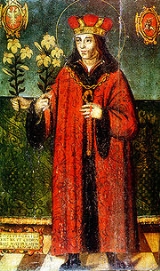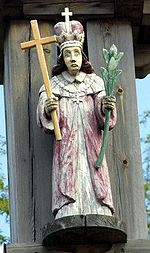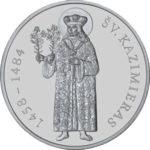
Saint Casimir
Encyclopedia


Kingdom of Poland (1385–1569)
The Kingdom of Poland of the Jagiellons was the Polish state created by the accession of Jogaila , Grand Duke of Lithuania, to the Polish throne in 1386. The Union of Krewo or Krėva Act, united Poland and Lithuania under the rule of a single monarch...
and of the Grand Duchy of Lithuania
Grand Duchy of Lithuania
The Grand Duchy of Lithuania was a European state from the 12th /13th century until 1569 and then as a constituent part of Polish-Lithuanian Commonwealth until 1791 when Constitution of May 3, 1791 abolished it in favor of unitary state. It was founded by the Lithuanians, one of the polytheistic...
who became a patron saint
Patron saint
A patron saint is a saint who is regarded as the intercessor and advocate in heaven of a nation, place, craft, activity, class, clan, family, or person...
of Lithuania, Poland, and the young
Youth
Youth is the time of life between childhood and adulthood . Definitions of the specific age range that constitutes youth vary. An individual's actual maturity may not correspond to their chronological age, as immature individuals could exist at all ages.-Usage:Around the world, the terms "youth",...
.
Biography
A member of the Jagiellon dynastyJagiellon dynasty
The Jagiellonian dynasty was a royal dynasty originating from the Lithuanian House of Gediminas dynasty that reigned in Central European countries between the 14th and 16th century...
, Casimir was born at Wawel
Wawel
Wawel is an architectural complex erected over many centuries atop a limestone outcrop on the left bank of the Vistula River in Kraków, Poland, at an altitude of 228 metres above the sea level. It is a place of great significance to the Polish people. The Royal Castle with an armoury and the...
, the royal palace
Wawel
Wawel is an architectural complex erected over many centuries atop a limestone outcrop on the left bank of the Vistula River in Kraków, Poland, at an altitude of 228 metres above the sea level. It is a place of great significance to the Polish people. The Royal Castle with an armoury and the...
in Kraków
Kraków
Kraków also Krakow, or Cracow , is the second largest and one of the oldest cities in Poland. Situated on the Vistula River in the Lesser Poland region, the city dates back to the 7th century. Kraków has traditionally been one of the leading centres of Polish academic, cultural, and artistic life...
, and died at Hrodna
Hrodna
Grodno or Hrodna , is a city in Belarus. It is located on the Neman River , close to the borders of Poland and Lithuania . It has 327,540 inhabitants...
.
St. Casimir was the grandson of Jogaila
Jogaila
Jogaila, later 'He is known under a number of names: ; ; . See also: Jogaila : names and titles. was Grand Duke of Lithuania , king consort of Kingdom of Poland , and sole King of Poland . He ruled in Lithuania from 1377, at first with his uncle Kęstutis...
and was the second son of king of Poland and Grand Duke of Lithuania Casimir IV and Queen Elisabeth Habsburg of Hungary. His maternal grandfather was the king Albert Habsburg of Hungary
Albert II of Germany
Albert the Magnanimous KG was King of Hungary from 1438 until his death. He was also King of Bohemia, elected King of Germany as Albert II, duke of Luxembourg and, as Albert V, archduke of Austria from 1404.-Biography:Albert was born in Vienna as the son of Albert IV, Duke of Austria, and Johanna...
, king of Bohemia
Bohemia
Bohemia is a historical region in central Europe, occupying the western two-thirds of the traditional Czech Lands. It is located in the contemporary Czech Republic with its capital in Prague...
and "King of the Romans
King of the Romans
King of the Romans was the title used by the ruler of the Holy Roman Empire following his election to the office by the princes of the Kingdom of Germany...
" of the Holy Roman Empire
Holy Roman Empire
The Holy Roman Empire was a realm that existed from 962 to 1806 in Central Europe.It was ruled by the Holy Roman Emperor. Its character changed during the Middle Ages and the Early Modern period, when the power of the emperor gradually weakened in favour of the princes...
.
From the age of nine, St. Casimir was educated by Jan Długosz and Filippo Buonaccorsi (also known as Filip Callimachus
Filip Callimachus
Filippo Buonaccorsi, called "Callimachus" was an Italian humanist and writer.-Life:...
). Casimir, eager to defend Christianity
Christianity
Christianity is a monotheistic religion based on the life and teachings of Jesus as presented in canonical gospels and other New Testament writings...
against the Turks
Ottoman Empire
The Ottoman EmpireIt was usually referred to as the "Ottoman Empire", the "Turkish Empire", the "Ottoman Caliphate" or more commonly "Turkey" by its contemporaries...
, accepted the offer and went to Hungary to obtain the crown. His uncle Władysław III, king of Poland and Hungary, had been killed earlier at the Battle of Varna
Battle of Varna
The Battle of Varna took place on November 10, 1444 near Varna in eastern Bulgaria. In this battle the Ottoman Empire under Sultan Murad II defeated the Polish and Hungarian armies under Władysław III of Poland and János Hunyadi...
in 1444 while leading the Hungarian armies against the Ottomans. Casimir was unsuccessful in this undertaking and returned as a fugitive. His father, King Casimir IV, had him educated well concerning public affairs and when his brother Władysław, became king of Bohemia, Casimir became crown prince
Crown Prince
A crown prince or crown princess is the heir or heiress apparent to the throne in a royal or imperial monarchy. The wife of a crown prince is also titled crown princess....
and heir-apparent to the throne of Poland.
In 1471, while King Matthias Corvinus of Hungary led a campaign in Bohemia, the Hungarian nobility conspired against him and called the thirteen years old Casimir to the Kingdom, so he could take over and be crowned. The conspiracy was led by the Hungarian Archbishop János Vitéz
János Vitéz (archbishop)
János Vitéz was the Hungarian archbishop of Esztergom and a prominent humanist, diplomat, Latinist, mathematician, astrologist and astronomer....
, but it was frustrated as the King Matthias learned about it and quickly travelled back to the Kingdom with his armies in May of the same year. Casimir arrived to the fortress of Nitra, and then to Perény and Rozgony, but for December he had to fled from Hungary, as the King recovered full control and arrested the traitors.
Between 1479 and 1484 his father spent most of his time in Vilnius
Vilnius
Vilnius is the capital of Lithuania, and its largest city, with a population of 560,190 as of 2010. It is the seat of the Vilnius city municipality and of the Vilnius district municipality. It is also the capital of Vilnius County...
attending to the affairs of Lithuania, while Casimir acted as the vice-regent in Poland. Between 1481 and 1483, he administered the state with great prudence and justice. His father tried to arrange a marriage with a daughter of Emperor Frederick III
Frederick III, Holy Roman Emperor
Frederick the Peaceful KG was Duke of Austria as Frederick V from 1424, the successor of Albert II as German King as Frederick IV from 1440, and Holy Roman Emperor as Frederick III from 1452...
, but Casimir preferred to remain single. Weakened by excessive fasting, he developed severe lung problems, possibly tuberculosis
Tuberculosis
Tuberculosis, MTB, or TB is a common, and in many cases lethal, infectious disease caused by various strains of mycobacteria, usually Mycobacterium tuberculosis. Tuberculosis usually attacks the lungs but can also affect other parts of the body...
. On a journey to Lithuania in 1484, he died at Hrodna
Hrodna
Grodno or Hrodna , is a city in Belarus. It is located on the Neman River , close to the borders of Poland and Lithuania . It has 327,540 inhabitants...
. His remains were interred in Vilnius
Vilnius
Vilnius is the capital of Lithuania, and its largest city, with a population of 560,190 as of 2010. It is the seat of the Vilnius city municipality and of the Vilnius district municipality. It is also the capital of Vilnius County...
. His remains rest in the baroque Saint Casimir's Chapel in the Vilnius Cathedral
Vilnius Cathedral
The Cathedral of Vilnius is the main Roman Catholic Cathedral of Lithuania.It is situated in Vilnius Old Town, just off of Cathedral Square. It is the heart of Lithuania's Catholic spiritual life....
.
St. Casimir lived and reigned with great dignity and possessed great charm and character. Several miracles are ascribed to him. He was canonized by Pope Adrian VI
Pope Adrian VI
Pope Adrian VI , born Adriaan Florenszoon Boeyens, served as Pope from 9 January 1522 until his death some 18 months later...
in 1522 and is the patron saint
Patron saint
A patron saint is a saint who is regarded as the intercessor and advocate in heaven of a nation, place, craft, activity, class, clan, family, or person...
of Lithuania. On June 11, 1948, Pope Pius XII
Pope Pius XII
The Venerable Pope Pius XII , born Eugenio Maria Giuseppe Giovanni Pacelli , reigned as Pope, head of the Catholic Church and sovereign of Vatican City State, from 2 March 1939 until his death in 1958....
named Saint Casimir the special patron of all youth.
The towns of Kvėdarna and Nemunaitis in Lithuania have Saint Casimir depicted on their Coat of Arms.
Ancestry
See also
- Kaziuko mugėKaziuko mugeKaziuko mugė is a large annual folk arts and crafts fair dating to the beginning of the 17th century. It was originally held at the two main markets in Vilnius, Lithuania, as well as in the city streets....
in VilniusVilniusVilnius is the capital of Lithuania, and its largest city, with a population of 560,190 as of 2010. It is the seat of the Vilnius city municipality and of the Vilnius district municipality. It is also the capital of Vilnius County...
, a fair held on the Sunday nearest to St. Casimir's Day, the anniversary of his death - Saint Casimir's DaySaint Casimir's DaySaint Casimir's Day is celebrated on March 4th, the anniversary of the death of Saint Casimir, the patron saint of Lithuania and Poland. The Kaziuko mugė, a folk arts and craft fair, is traditionally held on the Sunday nearest to March 4th....
(his feast day, March 4)

